Extract from The Guardian
From drought-hit
Nigeria to wine-growing Finland, we hear from people whose lives have
already been changed by a warming world
A man bathes in the Bratmaputra river in Guwahati,
Assam. Many Indian states have been affected by drought and water
scarcity this year. Photograph: STR/EPA
Patrick
Kingsley, John
Vidal, Oliver
Milman, Michael
Slezak, Vidhi
Doshi, David
Crouch, Oliver
Holmes, Jonathan
Watts, Shaun
Walker
Monday
14 November 2016 23.03 AEDT
Nigeria
In
the displacement camps of north-east Nigeria,
most residents have the same answer for why 2.6 million people have
been forced from their homes in this region. They are running from
Boko Haram, the jihadist militants who still control significant
parts of the Lake Chad basin.
But
ask about how Boko Haram gained momentum in the first place, and a
more complex narrative emerges. The extremists capitalised on high
levels of local poverty, alienation and unemployment in north-east
Nigeria. And that in turn, many local residents argue, was fuelled –
in part – by the shrinking of Lake Chad, and the desertification of
the surrounding area. With global temperatures soaring ever higher,
it’s a trend unlikely to be reversed any time soon.
“It’s
affected our livelihood, it’s affected farming and fishing,” says
Mustapha Ali, a 50-year-old who grew up close to the lake’s former
shores, and who is now living in a camp for internally displaced
people. “We used to farm watermelon here, wheat, and rice – but
because of the shrinkage of the lake, we can’t any more. Little by
little it became harder and harder to [irrigate the] farm.”
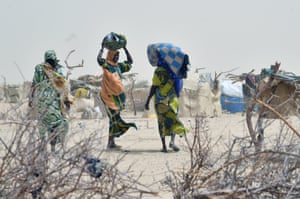
Women
arrive in a camp in the village of Kidjendi after fleeing from Boko
Haram attacks. Photograph: Issouf Sanogo/AFP/Getty Images
Since
the 1970s, global warming has caused the lake to shrink by around
90%. Once one of the world’s biggest lakes, at 25,000 sq km, it is
now less than 2,500 sq km. Towns that Ali remembers reaching by boat
can now be reached by car. At least one settlement has even been
built on land that used to be underwater, Ali says.
For
residents like Ali, the desperation caused by the shrinking of the
lake was clearly a contributing factor to the rise of extremism.
“It’s
helped the rise of Boko Haram,” Ali adds. “A lot of the youth
there were unemployed, and when they have nothing to do, Boko Haram
becomes an option. If you’re wealthy and you have things to do, you
don’t want things like [Boko Haram] to happen.” Patrick
Kingsley at Lake Chad
US
The
Iditarod Trail Sled dog race is a fabled 1,000-mile-long trek through
Alaska’s frozen wilderness, held annually since 1967. Unusually
warm weather prompted a change in the starting location for last
year’s race, while 7,000 gallons of snow was shipped in ahead of
this year’s event in case of a lack of powder. The race, held in
March, followed Alaska’s second warmest winter on record – the
latest in a string of warm winters.
Chas
St George, chief operations officer at the Iditarod trail committee,
said: “You have ups and downs in terms of snow but this year and
the year before were very mild in terms of weather and snowfall. Our
creeks are flowing earlier and we are also getting more sun, which
provides its own challenge for the people racing.
“Last
year we staged the race out of Fairbanks because of a lack of snow,
which is quite a distance further north. It’s cooler there, there’s
more snow. We’ve only been forced to do that kind of thing in the
last few years. There are times when these teams run on no snow at
all. The question is whether you have enough snow at the start, until
you get to the interior.

The
ceremonial start of the course in Anchorage, Alaska, had to be
shortened due to lack of snow. Photograph: Alamy Stock Photo
“This
year for the ceremonial start, where people come out to watch the
teams through Anchorage, we had to shorten the course from 11 miles
to three miles. That was for safety reasons because there was only
enough snow to get to a certain point. We haven’t had to shorten
the course like that before.
“When
it thaws and then freezes, all what’s left is ground that is still
frozen, it’s very slick ice. It becomes a safety issue. People want
to go as far as they can, that’s what they do this for, but they
were very understanding. I’m sure the dogs were disappointed.
“We
did have a contingency to get more snow in by rail this past year. It
wasn’t needed though, we had enough snow, thank goodness. In parts
of the course there was very little snow and then suddenly a huge
amount of it hit.
“In
Alaska there’s a ton of research that shows we are sort of at
ground zero here [for climate change]. There’s been a clear warming
trend. I don’t see significant changes to the race in the next
couple of years but over the next 20 to 30 years we might have to
look at it through a different lens. We may have to do things
differently. But we want to keep this tradition going.” Oliver
Milman in New York
Russia
Rodion
Sulyandziga of the Center for Support of Indigenous Peoples of the
North. Photograph: Courtesy of Rodion Sulyandziga
Rodion
Sulyandziga, who runs the Moscow-based Center for Support of
Indigenous Peoples of the North, says climate change is now one of
the key challenges facing Siberia’s numerous indigenous
communities.
Many
ordinary Russians laugh at the idea of global warming as a threat,
pointing out that much of the country would benefit from warmer
temperatures. But melting permafrost could create real problems for
communities in the far north of the country.
“Climate
change is already here and is already affecting the lives of most of
the indigenous community populations in the far north and Siberia, in
various different ways,” said Sulyandziga.
The
dangers were brought into sharp focus earlier this year when an
anthrax outbreak hit the Yamal peninsula which killed a child, left
23 people dead and also killed more than 2,000 reindeer. The Arctic
region is mainly populated by nomadic reindeer herders. There have
been discussions about reducing the reindeer population to insure
against future outbreaks, with radical suggestions including culling
200,000 animals.
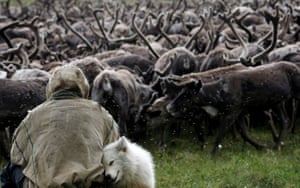
The
Arctic region is mainly populated by nomadic reindeer herders.
Photograph: Denis Sinyakov / Reuters/Reuters
The
working hypothesis for the deaths is that the infection was started
when the corpses of reindeer that died many years ago were uncovered
due to melting permafrost. This summer was abnormally warm in Yamal.
“At
a governmental level, it’s really important that Russia ratifies
the Paris agreement and gets to work on developing a national
strategy,” said Sulyandziga. “But we are also trying to work on
strategies in each region, and make sure local indigenous communities
are involved, to help protect these traditional ways of life.”
Sulyandziga’s
centre works to ensure representatives of the communities themselves
also have a say in discussions with authorities on how to mitigate
the consequences of climate change. Fighting for indigenous rights is
not always easy in Russia: Sulyandziga has been, on various
occasions, fined, banned from leaving the country, and forced to
declare his organisation a “foreign agent”. Shaun
Walker in Moscow
India
In
the town of Phalodi, surrounded by the Rajasthani deserts of
western India,
the mercury hit 51C in May, the highest recorded temperature in Asia
since 1956. As a result, people generally stopped working during the
main heat of the day.
Firoz
Khan: ‘It was difficult even to leave the house.’ Photograph:
Vidhi Doshi
Firoz
Khan, a nurse in the local hospital recalls that life in the village
came to a standstill. “It was difficult even to leave the house,”
he said. “Everyone was fretting.”
The
100,000 residents of Phalodi are used to extreme heat in the summers,
but this year was exceptionally bad, and the normal working routine
was disrupted. “It was very, very hot. You’d start sweating if
you stepped out of your house,” Khan recalled.
“In
fact, most people only worked in the mornings, from dawn until
10-11am, and then they’d have to stay in all day because of the
heat. Then around 5-6pm, people would leave home again and do a few
more hours of work. Farmers lost around half their crop because of
the heat this year. But at the time, they didn’t care. They just
wanted to sit indoors, under the fan or air conditioner.”
At
the hospital where he works, Khan saw dozens of people coming in with
heatstroke. “They just couldn’t take it. People were vomiting,
they were suffering from diarrhoea or dysentery, and they were
finding it difficult to urinate. A handful of people from the town
died because of the heat. They were older people, including a couple
of women. For others, it was too hot, even to leave home to come to
the hospital.”
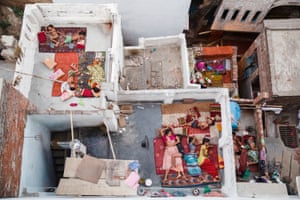
Families
sleep on the roof of their homes as temperatures soar in Varanasi,
India. Photograph: Yasmin Mund / Barcroft Media
Schools
were forced to close down, or send children home after a few hours of
study, at 11am.
In
the surrounding villages water shortages devastated crops. “There
was enough water to drink from the rainwater harvesting tanks, but
those who rear animals really suffered because there wasn’t enough
water for them,” said Khan. Vidhi
Doshi in Mumbai
Finland
French
winemakers joke about harvesting grapes on skis. But Fredrik Slotte,
36, who has 850 vines on his farm in Finland,
has the last laugh.
Last
autumn at a festival in the US his sparkling wines won a gold medal,
beating competition from 2,000 wines from 12 countries, including
French champagne.
“It
is great to see that Finland can compete in blind tastings with
France,” Slotte said.
This
summer has been a particularly good one for grapes on the Baltic
island of Åland, where Slotte has his vineyard. The spring came
early, and there was no frost. May was very warm, so the flowering
started quickly in June.
“We
got a long period from the flowering to the harvest, and it was very
dry,” Slotte said. “During the maturing process I want the grapes
to be as concentrated as possible, and every drop of rain dilutes my
wine and risks mould.”
Slotte
has been growing grapes in Finland since 1998, when everyone thought
he was “crazy”. But with an embryonic commercial wine industry in
neighbouring Sweden and Denmark, no one thinks that any more.
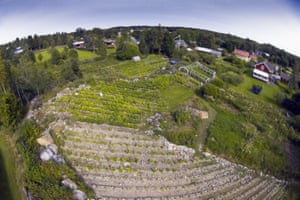
Longer
drier summers are boosting the Nordic wine industry. Photograph:
Olivier Morin/AFP/Getty Images
Swedish
winegrowers say that, thanks to climate change, they now have an
extra month in the growing season each summer compared to 40 years
ago, when the Septembers were not as warm as they are today. Some
growers can
even harvest their grapes at the end of August.
Ironically,
while his grapes did well this year, Slotte was hit because he also
grows wheat, which suffered from the heat and dryness. But he is
expecting a good vintage from 2016.
“There
are a lot of factors in making good wine, not just climate change,”
he said. “But if you want a deep style with a lot of body, you want
a good year like this.” David
Crouch in Gothenburg
Thailand
Thailand suffered
its worst drought in two decades this year, focused in the country’s
arid north-east where reservoirs are at record low levels.
Arkom
Kammag, 37, grows figs and raspberries for a family business in
Nakhon Ratchasima, one of the worst-hit provinces. The rainy season
brought some relief this year but just ended, he said, and it started
late. During the toughest months, mud – not water – was coming
out of the taps.
“Trees
were drying up and some grew really, really slowly,” he said. “It’s
difficult to live in this kind of hot and dry weather.”
Kammag
and his family used to stock up on fresh rainwater to drink but for
the first time they’ve had to buy it. Resorting to underground
wells after surface water dried up, he also ran an expensive pump for
eight hours a day. Many farmers have been pushed into debt.
The
world’s second-largest sugar and rice exporter, Thailand saw a cut
in production for both crops after four consecutive years of
below-average rainfall. The government has spent more than £500m to
help farmers.
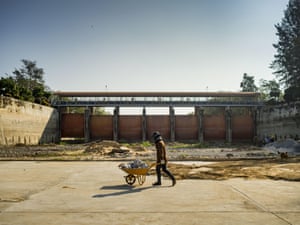
Maintenance
workers repair the spillway at Lam Takhong dam. Reservoirs in the
north-east of Thailand are at record low levels. Photograph: Alamy
Stock Photo
It
has imposed water rationing in some provinces and hotels have been
told to minimise their laundry loads. And China, which dammed much of
the upper Mekong river, agreed to release torrents of water to help
Thai farmers downstream.
Thailand’s
“Royal Rainmakers”, pilots who spray clouds with salt and
chemicals to encourage them to rain, were deployed – but many
reported the clouds were too thin to work with.
At
the annual Songkran festival in April, which transforms the streets
of Bangkok into a giant water fight during the peak of the dry
season, city officials tried to convince revellers to save water.
They shortened the festival from four to three days.
“This
is partly symbolic, but we hope to save water too because our lakes
have become deserts,” deputy Bangkok governor, Amorn Kijchawengjul,
said at the time.
“We
don’t want city folk splashing water around carelessly while
farmers struggle.” Oliver
Holmes in Bangkok
Australia
Vivien
Thomson, 51, is a wool, lamb, cattle and hay farmer in central New
South Wales in Australia, and an experienced firefighter. She lives
there with her husband Robert Flint, 55, and her youngest son Shaun
Flint, who is just finishing school this year.
The
hottest year on record hit them hard, Thompson says. But it’s just
another step in a scorching trend that she’s been dealing with for
years.
“You
expect to get one, two, maybe three days above 40C,” she said. “But
this year the heat was relentless. There never seemed to be a break.
And then it all stopped – bang – and you go from one extreme to
another.”
Thompson
said it makes life on the farm hard for everyone – and everything.
“It
affects your capacity to do so much. And for me, more importantly, it
affects the welfare of the animals on my farm,” she said.
Like
people, they don’t like to move around during the hottest times.
And as the hot periods extend, she said the periods of the day when
she can move the animals for a feed becomes shorter and shorter,
making their management harder and harder.
But
even more worryingly, dealing with water through such hot and
variable weather becomes a nightmare.
Thompson
said a cow might normally drink 20 litres of water a day. But on an
extremely hot day it can be as much as 100 litres. “So you have 100
cows, each drinking between 40 and 80 litres extra each day – those
dams are going to to drop pretty quickly,” she said.
To
cope with that, she had to move all the cattle to the paddocks where
the dams still had some water.
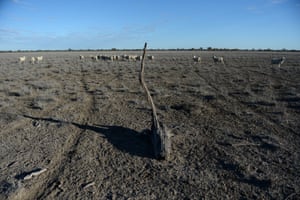
Sheep
in a dry paddock at a drought-affected property near Lightning Ridge,
NSW. Photograph: Dan Peled/AAP
At
one point, of her 35 paddocks, only two of them had dams with any
water left in them. But then the weather went from one extreme to
another. She was moving her stock to paddocks that had access to bore
water when suddenly a storm rolled in.
“It
only lasted for 15 minutes, my vehicle was aquaplaning across the
paddocks, and by the time it was finished, every dam was full. I’d
ridden the whole farm that morning and literally two of the 35
paddocks had water.”
Moving
the stock from one paddock to another to follow remaining water is
what she describes as “reactive” managing of the extreme heat.
But she’s also planning on longer timescales.
Because
the seasons aren’t predictable anymore, they are planting their hay
crops in three batches, hedging their bets. “So at least one will
probably be productive,” she said.
Hovering
over all of the animal and crop management issues is a big worry for
Thompson: fire. She used to be a professional firefighter and still
has a foot in the industry. She said she’s always had a plan to
fight fire when it approached her property, but the fire-weather has
become so bad recently, that she no longer thinks she can always do
that.
“My
husband is also a very experienced firefighter and we always believe
we stand a reasonable chance. But there was one day a couple of years
ago where the conditions were such that, we looked at each other and
said for the first time in our lives: if there’s a fire, we walk.
We’re not going to even try to fight it.”
“We
had never felt like that before,” she said. Michael
Slezak
Malawi
Peter
Phiri, a businessman in Lilongwe, Malawi,
said: “It is always hot here but this year El Niño has made it
worse. Last year we had floods and we lost crops. This year we had no
rain. Two years’ harvests have been hit hard and it has been
disastrous for many people. Because 90% of Malawians are farmers,
nearly half the country will need help with food.
“The
lack of rain means we have water shortages and the rivers and lakes
are low and the hydroelectric power does not work. There are long
power cuts. People in rural areas do not have electricity, but in the
cities this means homes and offices do not have air conditioning and
people have no way to keep cool.
Members
of the Majawa family walk to their church in the village of Mulele,
which lies in one of the areas most affected by drought in Zomba,
Malawi. Photograph: Andrew Renneisen/Getty Images
“Old
people say it is hotter now than years ago but it is hard for me to
tell. The rains are about to come and the temperature reaches 38, 40C
or more. Then it cools.
“One
reason for the heat could be that people have cut down trees to make
charcoal to earn money to eat, or to cure tobacco. Another could be
climate change. The cities may be getting hotter because they are
growing in size and people live in concrete houses.
“Over
the last 10 years people have noticed that the seasons are changing.
In the past the rains would come in October. Now it is November. The
‘lean’ season when people have less food to eat used to last
three months. Now it starts early and lasts longer.” John
Vidal
Brazil
For
five years, the farmers of Poço Redondo have suffered from a drought
that has devastated the crops of corn and beans on which they depend.
But in 2016 the situation deteriorated, according to Sival Lima de
Jesus.
Sival
Lima de Jesus, a farmer in Poço Redondo, which has suffered drought
for five years. Photograph: Jonathan Watts for the Guardian
The
smallholder in this poor north-west corner of Brazil says
his fields have had fewer than 10 days rain since January, which has
made the earth so dry it is impossible to plough.
“This
year was much worse than last,” he said. “We plant everything and
harvest nothing. We now just try to plant hay for the livestock, but
even that hasn’t been possible for many people this year. There is
a huge lack of water and food for the animals.”
He
said his small community of about 280 families now depends almost
entirely on the milk from their cows, though even that has reduced
dramatically - from 230 litres a day eight years ago to 30 litres a
day now - as a result of the harsh climate.
“Economically
it is terrible,” he laments. “At least 30% of the livestock have
gone, either starved or died.”
There
is a huge lack of water and food for the animals, farmers say.
Photograph: Lunae Parracho / Reuters/Reuters
He
and his neighbours rely more heavily than ever on bolsa familia
poverty relief payments from the government, though he said these
have been cut for many families. Making matters worse, young people,
who used to travel to the cities for work, are starting to return
because there are so many lay-offs in the midst of Brazil’s
recession.
“People
are starting to go hungry,” the farmer said. “It’s been years
since we have seen people begging around here, but we have started to
see this again.” Jonathan
Watts
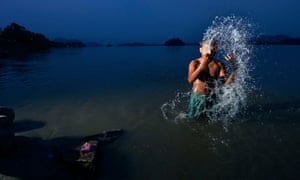
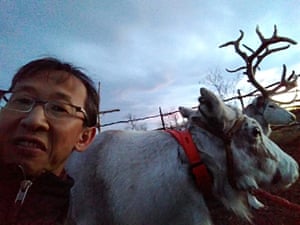
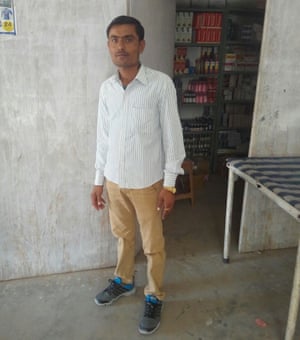
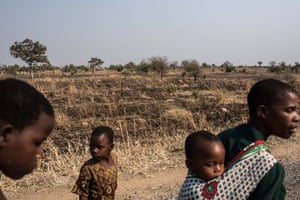
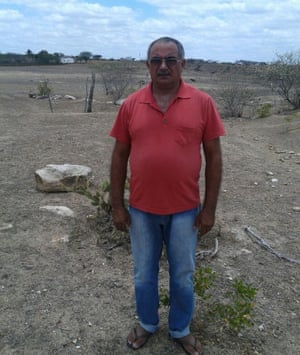
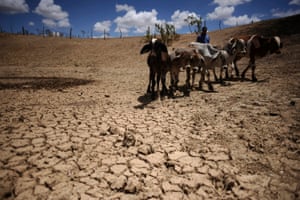
No comments:
Post a Comment